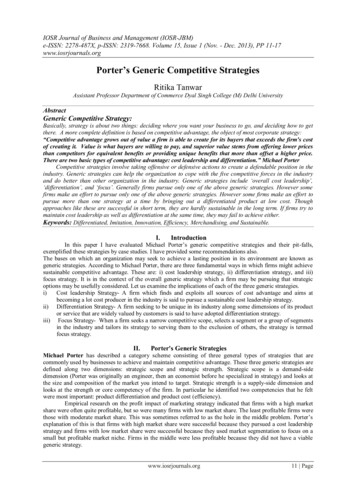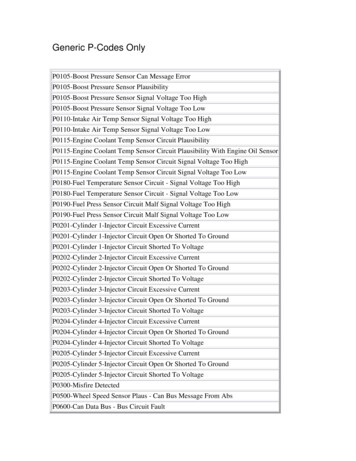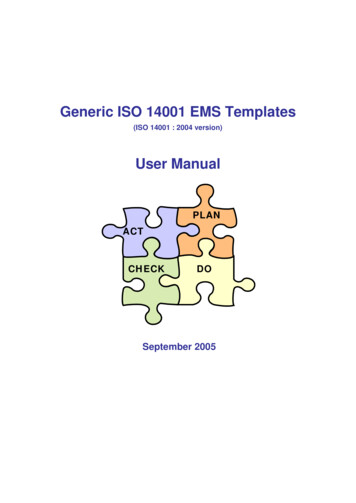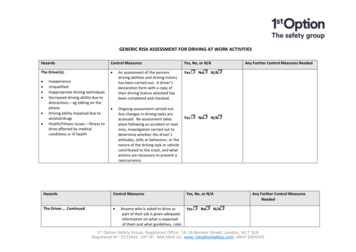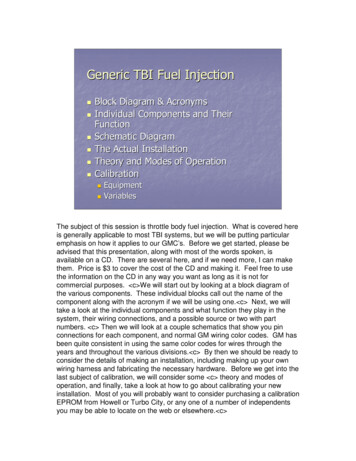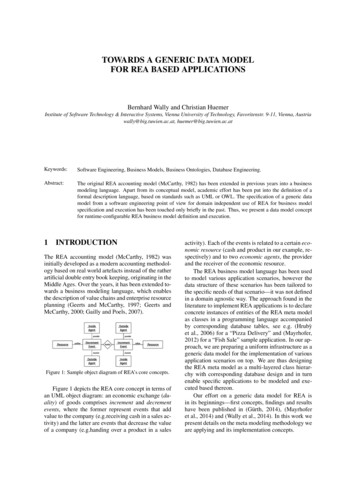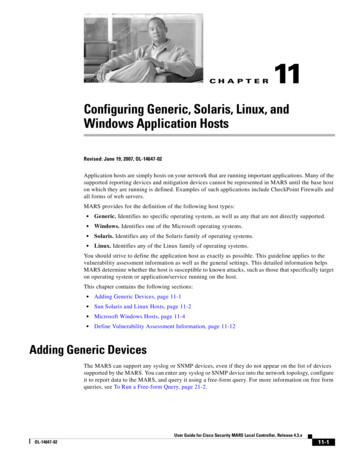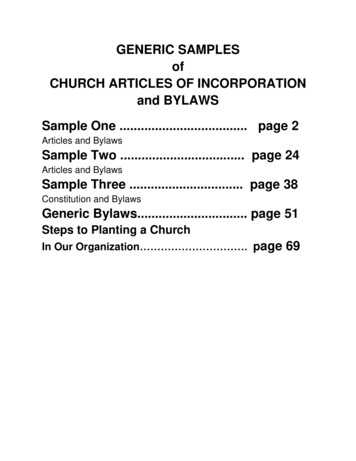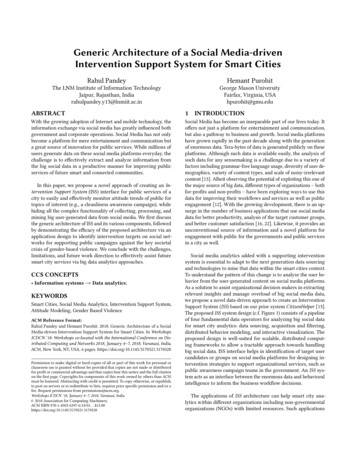
Transcription
Generic Architecture of a Social Media-drivenIntervention Support System for Smart CitiesRahul PandeyHemant PurohitThe LNM Institute of Information TechnologyJaipur, Rajasthan, Indiarahulpandey.y13@lnmiit.ac.inGeorge Mason UniversityFairfax, Virginia, USAhpurohit@gmu.eduABSTRACT1With the growing adoption of Internet and mobile technology, theinformation exchange via social media has greatly influenced bothgovernment and corporate operations. Social Media has not onlybecome a platform for mere entertainment and communication buta great source of innovation for public services. While millions ofusers generate data on these social media platforms everyday, thechallenge is to effectively extract and analyze information fromthe big social data in a productive manner for improving publicservices of future smart and connected communities.Social Media has become an inseparable part of our lives today. Itoffers not just a platform for entertainment and communication,but also a pathway to business and growth. Social media platformshave grown rapidly in the past decade along with the generationof enormous data. Tera-bytes of data is generated publicly on theseplatforms. Although such data is available easily, the analysis ofsuch data for any sensemaking is a challenge due to a variety offactors including grammar-free language usage, diversity of user demographics, variety of content types, and scale of noisy-irrelevantcontent [13]. Albeit observing the potential of exploiting this one ofthe major source of big data, different types of organizations – bothfor-profits and non-profits – have been exploring ways to use thisdata for improving their workflows and services as well as publicengagement [12]. With the growing development, there is an upsurge in the number of business applications that use social mediadata for better productivity, analysis of the target customer groups,and better customer satisfaction [16, 22]. Likewise, it provides anunconventional source of information and a novel platform forengagement with public for the governments and public servicesin a city as well.In this paper, we propose a novel approach of creating an Intervention Support System (ISS) interface for public services of acity to easily and effectively monitor attitude trends of public fortopics of interest (e.g., a cleanliness awareness campaign), whilehiding all the complex functionality of collecting, processing, andmining big user-generated data from social media. We first discussthe generic architecture of ISS and its various components, followedby demonstrating the efficacy of the proposed architecture via anapplication design to identify intervention targets on social networks for supporting public campaigns against the key societalcrisis of gender-based violence. We conclude with the challenges,limitations, and future work direction to effectively assist futuresmart city services via big data analytics approaches.CCS CONCEPTS Information systems Data analytics;KEYWORDSSmart Cities, Social Media Analytics, Intervention Support System,Attitude Modeling, Gender Based ViolenceACM Reference Format:Rahul Pandey and Hemant Purohit. 2018. Generic Architecture of a SocialMedia-driven Intervention Support System for Smart Cities. In WorkshopsICDCN ’18: Workshops co-located with the International Conference on Distributed Computing and Networks 2018, January 4–7, 2018, Varanasi, India.ACM, New York, NY, USA, 6 pages. https://doi.org/10.1145/3170521.3170528Permission to make digital or hard copies of all or part of this work for personal orclassroom use is granted without fee provided that copies are not made or distributedfor profit or commercial advantage and that copies bear this notice and the full citationon the first page. Copyrights for components of this work owned by others than ACMmust be honored. Abstracting with credit is permitted. To copy otherwise, or republish,to post on servers or to redistribute to lists, requires prior specific permission and/or afee. Request permissions from permissions@acm.org.Workshops ICDCN ’18, January 4–7, 2018, Varanasi, India 2018 Association for Computing Machinery.ACM ISBN 978-1-4503-6397-6/18/01. . . UCTIONSocial media analytics added with a supporting interventionsystem is essential to adapt to the next generation data sourcingand technologies to mine that data within the smart cities context.To understand the pattern of this change is to analyze the user behavior from the user-generated content on social media platforms.As a solution to assist organizational decision makers in extractingrelevant insights and manage overload of big social media data,we propose a novel data-driven approach to create an InterventionSupport System (ISS) based on our prior system CitizenHelper [13].The proposed ISS system design (c.f. Figure 1) consists of a pipelineof four fundamental data operators for analyzing big social datafor smart city analytics: data sourcing, acquisition and filtering,distributed behavior modeling, and interactive visualization. Theproposed design is well-suited for scalable, distributed computing frameworks to allow a tractable approach towards handlingbig social data. ISS interface helps in identification of target usercandidates or groups on social media platforms for designing intervention strategies to support organizational services, such aspublic awareness campaign teams in the government. An ISS system acts as an interface between the enormous data and behavioralintelligence to inform the business workflow decisions.The applications of ISS architecture can help smart city analytics within different organizations including non-governmentalorganizations (NGOs) with limited resources. Such applications
Workshops ICDCN ’18, January 4–7, 2018, Varanasi, IndiaPandey et al.Figure 1: A generic architecture diagram for Intervention Support Systemcould help make decisions on the basis of intelligent insights ofpublic participation as well as user-generated content analysis onsocial media to redefine the organizational actions and activitiesfor the general benefit of the target users. This could be easilyobserved with the increasing number of domains adopting socialmedia strategies. For instance, an ISS can be used for public healthissues to predict attitude trends of public towards flu shots usingTwitter data [16], or for gauging public attitude towards upcomingsocio-economic policies to encourage crowd-participation in policy making through Twitter [7], or understanding public attitudetowards more socially-sensitive issues like gender-based violence[19] for assisting social activist NGOs. Application of ISS-drivenmodel can also be used by political parties to examine the patternof voter wishes on specific issues, or by companies to analyze theeffect of a new product launch and its expected reach, or by NGOsto examine the demographic groups affected by specific biases inany region.Given that the proposed ISS design has a generic architecture,it could be customized as per the need of the end users by thedomain and relevant tasks of the organizational actors. To verifyand validate the proposed architecture, we demonstrate an ISS toassist an NGO or governmental agency in selecting a group ofTwitter users for intervention related to gender-based violence, bymodeling the various relational factors (c.f. Figure 2) guided bysocio-psychological theories for inference of attitude of the users.This system not only aims to help the NGOs to put their limitedresources to effective use, but also helps them to know their targetcustomer audience, i.e. public, better based on the content postedby public on social media.The rest of the paper is organized as follows. Section 2 provides the theories supporting the design and architecture of themodel based on psychological and practical heuristic approaches.In Section 3, we describe the generic architecture of ISS and thecharacteristics of its various components. Section 4 presents detailson a demonstration of the ISS architecture in a practical applicationof gender-based violence using data from Twitter micro-bloggingservice. Finally, section 5 presents contributions of this genericframework, limitations with the current system, and future work.2RELATED WORKWe discuss the related work across three different focus areas: first,the social media applications in diverse domains; second, the social media research in modeling user behavior and correspondingsocio-psychological theories that are relevant to inform architecture design of an ISS, and lastly, the relevant software architectureparadigms.In recent years, we have observed a new way of large-scale information exchange, where many users spread their views on socialmedia channels like Twitter, Facebook, YouTube, Instagram etc.Over the past few years, researchers have tried to exploit socialmedia data and extract meaningful insights for applications in various domains [20, 24]. One such application by Asur and Huberman(2010) [2] was to help predict the future with social media by exploiting Twitter data to forecast box-office revenues for movies
Generic Architecture of a Social Media-drivenIntervention Support System for Smart Citiesin the entertainment domain. Similarly, Aramaki et al. (2011) andAchrekar et al. (2011) [1] exploited Twitter data for a real-timeassessment to predict flu for public health domain. The model of[1] was trained with the help of the data collected by U.S. Centerfor Disease Control and Prevention (CDC) and showed that Twitterdata can improve the model prediction accuracy for flu outbreaks.There are numerous other examples in which social media data hasimproved the reliability of the current systems, developed novelprediction models for social network analysis, and assisted identification and classification of the user demographic groups. Majorityof such relevant works have potential to inform applications in thecontext of smart city analytics. Therefore, social media shows apromise to provide a novel information platform for interventionstrategies also for end users of an organizational service in futuresmart cities, by modeling individual user and group level behaviorsfrom the social media content.Social Media is a major, unprecedented source for understandinga user’s social behavior. Many research studies in the emerging fieldof Computational Social Science [15] have been conducted recentlyto use this data to model user’s psychological traits [4, 6, 17], whichhave numerous applications in the real world. Understanding socialpsychological factors affecting human attitude such as unconsciousbias, aggression, stereotyping, and belief with humor/sarcasm havea vital role in understanding user actions on social media. Thecorrect identification of user and group level behaviors on socialmedia presents a complementary approach to existing methodsof survey-driven approaches for helping organizational actors intervene effectively for their end users, i.e. public in the case ofsmart city governments. Therefore, modeling such behavioral traitshave an important role in the design of an ISS. We briefly describethese psychological concepts [11, 18] to better inform a reader inthe following. Attitude is an evaluation of an object, person, act,etc. The attitude can be explicit and implicit, and can be weak orstrong, positive or negative. Stereotyping is a thought that can beadopted about specific types of individuals or certain ways of doingthings. These thoughts or beliefs may or may not accurately reflectreality. Similarly, unconscious bias is a construct that is created andreinforced by our environments and experiences. Our mind is constantly processing information, oftentimes without our consciousawareness and therefore, our behavior has some impact due to thispsychological construct. Microaggression is a subtle but offensivecomment or action directed at a minority or other non-dominantgroup that is often unintentional or unconsciously reinforces astereotype.To leverage the theoretical understanding of the socio-psychologicalconcepts, recent social media mining studies enable computationalmodeling of some of these constructs. Gao et al. [10] have proposeda method for attitude modeling on Twitter data based on the factthat in recent years many users have spread their views on thismicro-blogging site on certain topics and if a user retweets/forwardsspecific tweet messages, it has likely some opinions on the topicof the tweet content. The authors model attitude by defining relationship between user’s opinions, sentiments, and action (the actof retweet). Using Matrix factorization, the authors successfullybuilt a classifier model for predicting the user action of retweet. InWorkshops ICDCN ’18, January 4–7, 2018, Varanasi, Indiaanother study, researchers used the microblogging site of Twitterto capture cultural differences in expressions of intentions [21]. Inthis approach, authors demonstrated a latent representation of anindividual’s culture derived from its intentions to explore the intersection between culture and intentions, by using the vast amountof written expressions in users’ historic profile data on Twitter.The authors used hashtags as cognitive factors to represents user’sintention and used naive Bayes model to develop an intention classifier. Similarly, many studies deal with subjective behavior analysisof textual data, which is a very important foundation for buildingan Intervention Support System. For measuring the human psychological traits through textual information, one of crucial approachto processing the raw data is user attitude towards a target, suchas negative sentiment towards a product. Among the relevant approaches, [8] mined the target-based sentiments by extraction oftargets from data using Wikipedia/Wiktionary and then using theconstruction of a lexicon for target-specific polarity adjectives. [23]developed a three-class classifier that divides the tweets with giventargets into positive, negative, and neutral sentiment respectively;since the target is not randomly chosen, this approach is more reliable while not only considering the sentiments of the target, butalso the sentiment of the whole sentence.For the software design aspect of ISS, there are several approachesfor a system software design [5]. We rely on the scenario-basedsoftware architecture analysis proposed by [3, 14], given the diversenature of organizational needs for behavior modeling requirementsin a smart city analytics context. On one hand, the latest researchmethods show efficiency to achieve any sensemaking of the socialdata, while on the other hand, there is a gap in transforming theseresearch methods into a systematic social analytics software, whichcan provide the outcome of the isolated techniques of user behaviormodeling into a meaningful interface for organizations of smartcities. ISS present one alternative for this purpose of providing ameaningful interface for complex social media analytics.3INTERVENTION SUPPORT SYSTEM (ISS):GENERIC ARCHITECTUREThis section describes a generic architecture (Figure 1) of an Intervention Support System or ISS, which can predict the psychologicalattitude trend of a user sample on social media, by modeling conscious or unconscious bias behavior and affinity of the user towardsparticular groups/topics. The ISS design assumes the social media asits primary data source and builds upon a standard data operationpipeline observed in machine learning applications. The pipelineruns to first allow collection of training data samples for buildinga model of user or customer behavior, followed by employing thetrained model to predict user behavior on the new streaming content, in order to understand the general trend of behavior shift fora user group towards the targeted topics. The specific componentsof ISS and their connections summarized in Figure 1 are discussedbelow:(1) Data Source: Input data for the ISS model is from social media platforms such as Twitter, Facebook, Google , YouTube,etc. Since the social media sites have abundant users who
Workshops ICDCN ’18, January 4–7, 2018, Varanasi, IndiaPandey et al.cover all the range of topics in the conversations, the datasample has sparse distribution of the relevant information fororganizational services. Social media platforms provide APIssuch as Twitter Streaming API1 to collect data for the givencriterion of parameters (e.g., keywords, location boundingbox of a city or a region, etc.) for data collection as discussednext.(2) Data Acquisition and Filtering: The second step afterchoosing a platform for data collection is to filter the streaming data for further use in analytical modeling of interest.The first goal is to define target users of interest as we cannotgeneralize the behavior of all users on social media due todifferent demographics, culture, and interests of users. So westart with a selection of an event (e.g., launch of a activismcampaign) and all the users who have participated by postingmessages related to that event will become our target usersof interest. The relevant event message is filtered by a givenset of keywords to define the event or a specific locationbounding-box. After acquiring the users of our interest, wecrawl all the historical message data in the profiles of usersin our target user sample. For example, the user data in thecase of Twitter platform could be all the historical tweets.For Facebook, it would be all the posts in the timeline ofa user profile; for YouTube, it would be the comments andlikes by the users on videos. One can limit the time frame ofall the user data and the resulting data is further fed to thenext module in the pipeline for an insightful analysis of userbehavior.(3) Distributed Behavior Modeling: The third step is the crucial step for preparing and modeling user data to extractvaluable information for user behavior. The proposed design allows distributed computation of a variety of influencing factors for user behavior that are modeled on a givenuser’s historic data. For instance, to capture conscious andunconscious (implicit) biases for a user’s attitude, we usetwo different, parallel approaches. For the conscious bias,we define a set of topics of interest to an organization andthen compute the user’s attitude towards the topic, with agoal of capturing stereotyping behavior of the user for thegiven topics. These topics can be very generic or specificsuch as gender, race, religion, ethnicity, employment, andeven politics. For unconscious bias, we measure a differencebetween the likelihood of a user’s interaction with a givenpair of complementary communities such as male versusfemale. The individual behavioral factors are combined viaa machine learning model to predict whether a user will act(e.g., retweet on Twitter), given a social media message (e.g.,tweet on Twitter).(4) Prediction Modeling and Presentation: The final component gathers the output generated from the previous stepsand predict the trend of user attitude towards the subjectof interest, i.e. topics. The results are combined as per the1 r-realtime/overviewFigure 2: Relationship Graph Model.relationship graph model designed for the application domain (see Figure 2). A dashboard is developed to representthe results using visualization tools for providing better understanding to the end user, i.e., organizational actor.The generic architecture described in the previous section has manyapplications as discussed in the introduction. We demonstrate oneimplementation of ISS for a case of NGO who wants to curb thegender-based violence problem via an online awareness campaign.4ISS FOR CAMPAIGNS AGAINSTGENDER-BASED VIOLENCEWe demonstrate an instance of the generic architecture of ISS tobuild a system for assisting smart city organizations in identification of potential user targets for the interventions
George Mason University Fairfax, Virginia, USA hpurohit@gmu.edu ABSTRACT With the growing adoption of Internet and mobile technology, the information exchange via social media has greatly influenced both government and corporate operations. Social Media has not only become a platform for mere entertainment and communication but

